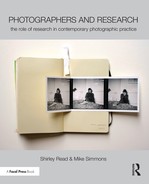Case Study
Subhankar Banerjee
Subhankar Banerjee is a photographer, writer and environmental humanities scholar.
FOR THE LAST DECADE OR SO, I have led a dual life. One part of me has been a photographer and the other part an independent environmental humanities scholar, so research is fundamental to many of the things that I do. I think of photography and research in very specific ways, but for me they are inseparable. One of the key components of my research process is the literature review (books, journals and online resources).
But equally important in the research process is fieldwork. For example, conversing with indigenous peoples, scientists and conservationists is crucial, as from this I begin to unravel the complexities and multiple perspectives within my subject. All of these things are part of my research, and are different from the way I work with photography, which is a much more informal and intuitive process.

Caribou Hunter – Jimmy John. Gwich’in and the Caribou.
Photography by Subhankar Banerjee, 2007.
For many artists, there is an idea in the beginning, and this dominates almost everything; but for me it is different. If you think about it as a contrast, an example would be Hiroshi Sugimoto. Sugimoto, for each of his well-known series, articulated an idea in the beginning, and the idea then provided the conceptual basis for many years of photography. But philosophically speaking I cannot have an idea at the start of a project; all I can have is a desire. In the Arctic, it was a kind of a romantic wish to live in a land untrammelled by tourism or industry. After the initial desire I begin to engage, and then the practice of photography and the research become like a DNA strand, the two co-evolve. And through that co-evolution process ideas emerge and only then can I begin to articulate the different strategies needed to explore and shape the ideas as they develop and mature. Let me give you some specific examples of how that has worked out.

Hulahula-Okpilak Delta I. Oil and the Caribou.
Photography by Subhankar Banerjee, 2002.
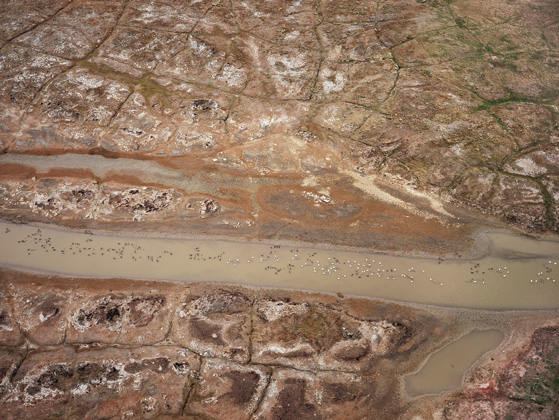
Brant and Snow Geese with Chicks. Oil and the Geese.
Photography by Subhankar Banerjee, 2006.
The first time I went to the Arctic was in late 2000. It was a small preliminary trip before the project began in earnest the following year, where I spent seven months in the field. And what I did during that time was frantically point my lens at everything, documenting what I could. When I came back, I realised that it was a futile attempt to try to document the Arctic for various reasons. The biodiversity is complex, the land is vast and there are multiple indigenous cultures, and documentation of all of that was not what I had gone there for. So I had to come up with a certain set of strategies related to what it was that I wanted to achieve, and how I wanted to communicate this through my photographs, now that I had the desire and the actual fieldwork had started. The research then began on many different fronts and I came up with a set of motifs, which would help to guide what I wanted to do.
From the research that had already started I asked a rather basic question: How do we perceive the far North? And the answer was primarily through the way that the pro-oil-development politicians have articulated it—’as a frozen or barren wasteland’, or a ‘flat white nothingness’, and also how the Arctic is depicted in popular culture—’as a land of snow and ice.’ In fact 60 Minutes, which is a popular news magazine TV programme in the United States, referred to it as a ‘hostile wasteland’. I realised perhaps that colour is a visual language through which we can unlearn some of these intolerances. So colour became my primary motif, not a medium (as colour has always been my medium), but colour as a way of understanding the environment.
I began asking very simple questions such as: Can I make work with white only, white and brown, white and blue or white and grey? The reason that I say this is because in the second year when I returned to the Arctic, I was consciously thinking these things. I had a sense, from being in the landscape, that this was possible. There were also aspects of minimalism or modernism coming in, which seemed appropriate as the colour that can be found in the Arctic has a restrained presence in a rather vast space. Like any other environment many different colours exist in the Arctic in all seasons, and with colour, we can create a language of justice or a language of how we really think, feel and talk about the North. The fact of being there alerted my mind to the possibilities, which I think is a really important aspect of fieldwork. But to become alert you sometimes have to make pictures in order to find out what you don’t want to do.
In the early years when I would be teaching a class, maybe giving an illustrated lecture for example, one question I would often get asked was: “What books did I carry out in the field?” And my response was always the same. When I am out in the field I have absolutely no books of any kind with me, and in a way it is like having a Jekyll and Hyde personality. When I am back home I am doing nothing but immersing myself in the literature, and when I am out in the field I am completely removed from that because I want my senses to be responsive to what I am seeing rather than responding to a set of preconceived notions that I might impose on them. Being in a particular place for months and months, I become attuned to the possibilities of seeing.
But there are times when the reverse happens, a situation that actually became the corpus of my latest book, Arctic Voices: Resistance at the Tipping Point.1 This was essentially a very simple photograph that I had taken in the second year I was out there. It was of a Gwich’in indigenous hunter2 on the land of one of the watchtowers. It was one amongst several other photographs of a hunting camp in the Arctic National Wildlife Refuge (NWR), near Arctic Village. On seeing the

‘Caribou Migration I. Oil and the Caribou.
Photography by Subhankar Banerjee, 2002.
photograph, one dedicated young environmentalist asked me a question: How could there be a hunting camp in a wildlife refuge? So, a photograph raised that question, and it caught me off guard because I had not really thought about it myself. I had taken it for granted that these things are there and I am photographing them. But that question led me on to many years of research into environmental history in America, and what came out from that was the sheer scale of the injustice done to Native Americans. And sometimes what environmental history has missed I have tried to retrieve by going into art history. A lot of my current research is at the intersection of those two perspectives.
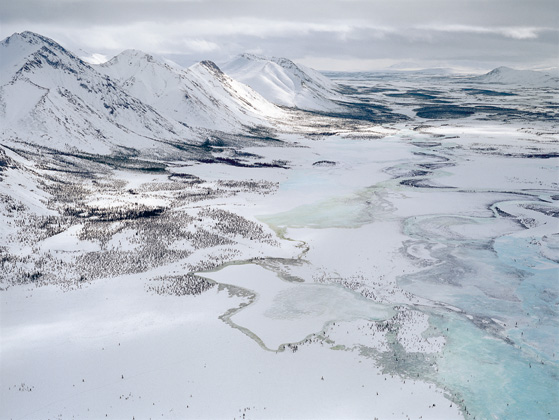
Sheenjek River II: A Gwich’in Homeland. Oil and the Caribou.
Photograph by Subhankar Banerjee, 2002.
To give you an example of how that works, I am conscious when I come back to the photographs that I begin to question the difficulties people might have in seeing certain images. In 2009 when I was the Artist-in-Residence at Dartmouth College, I presented a large Caribou migration photograph, with four small caribou harvest photographs and there were three
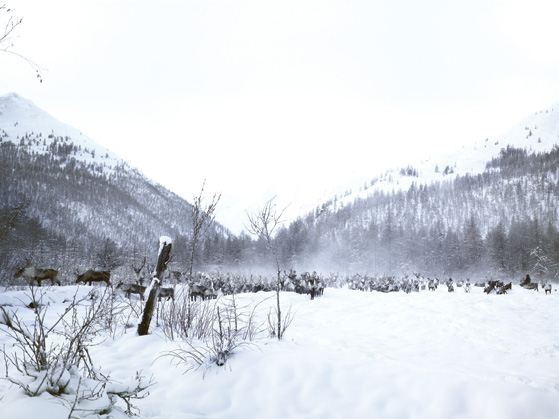
At the Corral – Nikolayev Matvey Gathering Reindeer. Even and the Climate.
Photograph by Subhankar Banerjee, 2007.
points of tension I was seeking to discuss with the juxtaposition: emotive response, scale and viewing distance, and environmental conservation. I have noticed that many viewers are attracted to the caribou migration photograph but repulsed by the harvest images in which blood is visible. Our modern cultures have got used to purchasing meat neatly packaged in plastic that seeing blood in meat has become disturbing for many people. The suite of caribou harvest photographs is addressing a historical problem and is an attempt to decolonise American environmentalism. It is also addressing a philosophical problem and is an attempt to recognise where our food comes from. The next point of tension is scale—to see the large caribou migration photograph we pull back, but to see the small harvest photographs we draw near. And, finally, environmental conservation as we feel compelled to protect the caribou and its habitat as wilderness that is untouched by humans. But humans have lived and depended on that caribou and the very same wilderness for many millennia and have established an ecospiritual3 relationship with the caribou. But that juxtaposition would not have been possible had I not gone into the research, but I would not have gone into the research unless the watchtower photograph had raised a question. So that is what I mean when I say it is like a DNA strand, the two processes are interlocked.

Loon Nest. Oil and Caribou.
Photography by Subhankar Banerjee, 2002.
Another case of how fieldwork has contributed to my research in a significant way occurred when I was out on the Arctic tundra. I was observing a Pacific loon on a nest by a lakeshore. Nothing particularly significant, and I could have simply photographed the natural history of it. But for some reason I was very immersed and alone at that time and became curious about what the loon does. What ended up happening was that I photographed the pair of birds (both parents share nesting duties) for almost two weeks—nothing but the loon on the nest rotating its head, through varieties of weather conditions that included clear days as well as days when snow fell on the tundra. The corpus of about 30 photographs became about survival. And that would not have been possible unless I was open to the idea that something entirely new could emerge. Then, of course, it led into research about the loon, and I came to know that loons are among the oldest surviving species on earth having been around for about 20 million years, but it was the engagement that led to that whole process.
What has happened is that my work has become gradually progressive, developing in stages over time. From the Arctic project, which required a huge amount of equipment and a lot of travel (including aerial photography with a large ecological footprint), to the Desert work where I was geographically bounded, working in an area literally within a five-mile radius of my house in New Mexico with a small amount of kit in a daypack. Walking around for a couple of hours and coming back to eat lunch and going out once again, with no particular schedule. Photography for me has become a philosophical engagement, because I myself am evolving and it is photography that is ensuring that process and forcing me to think differently.
However, to think differently is almost reaching towards a particular set of values with how I engage with the world—the idea of simplifying and slowing down. In the desert I was forced to slow down and look closely. Things that are far away are often considered exotic and rather easy to see, while things that are near and familiar are very hard to see because we take them for granted. My little five-mile area became an ecological paradise not unlike the Arctic. Even though visually photographs from the two series look entirely different the underlying themes are the same. I was actually doing the same thing in the desert that I did in the Arctic—building a social-ecological story of a particular place that has connections to global processes.

Caribou Skeleton. Oil and the Caribou.
Photography by Subhankar Banerjee, 2006.
The research process seen through the various stages of individual development is really about what we learn and re-apply or re-shape, so it’s not just specific to one thing in that sense, there is an evolution. With each project every artist has their own specific set of ideas and requirements, but across projects there is also an evolution that one goes through. In some of my lectures I have talked about art as knowledge, and for me that is really fundamental. That art or the interpretation of art can lead to a particular kind of knowledge that otherwise would not exist. Creating photographs is about extending my own knowledge and understanding of the subject, which raises questions of what and why am I doing what I am doing. Information can come from anywhere, from the scientific, the historic, the philosophic or even the vernacular. It is all about how we interpret that knowledge and how our interpretations are then translated into new understandings through the work we make.
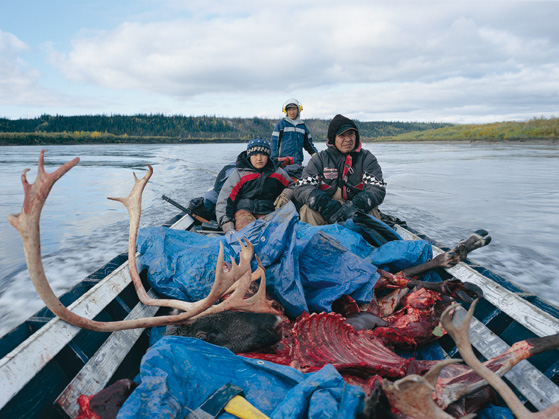
Caribou Hunt – Joe Tetlichi, Jamie and Shane. Oil and the Caribou.
Photography by Subhankar Banerjee, 2006.
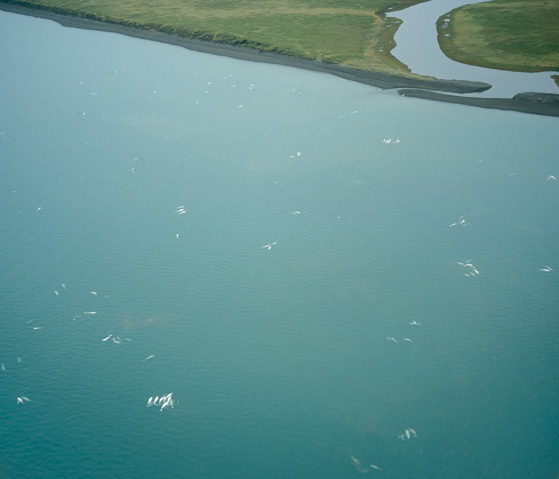
Beluga Whales with Calves. Oil and the Whales.
Photograph by Subhankar Banerjee, 2006.
The kind of knowledge that we may arrive at through the creation and interpretation of art is different from the kind of knowledge that is achieved through science. In science consistency within a particular theory is paramount, whereas in art and humanities the conflicts or contradictions within a particular space, ecological or social, can be important and this is about keeping an open mind. Art and humanities can hold those contradictions in place, as often these cannot be resolved anyway. In both of my engagements, with the Arctic and the desert, I came to realise that contradictions exist. If we ask a simple question—’What do you think of the Arctic National Wildlife Refuge?’—we might potentially get the following answers. ‘It’s home. To us it’s home,’ says Robert Thompson who is an Iñupiaq4 and lives in the Arctic. ‘It’s a beautiful landscape,’ says the tourist. ‘It’s a pristine wilderness untouched by man,’ says the conservationist. ‘It’s a frozen wasteland,’ says the politician. ‘It’s a nursery. This is where I was born,’ a bear or a caribou would say if they had a voice. They are all talking about the same piece of land.
I would have never imagined that my desert work would also highlight conflict in our imaginations. If we ask a simple question about a desert plant—‘What do you think of a cholla?’—we might potentially get the following answers. ‘I love the scarlet bloom on the chollas,’ says an Eldorado resident, where I lived and photograph. ‘It is a plant of the disturbed Earth’ or ‘it is a key indicator species of Native American habitation,’ says an anthropologist. ‘I removed them all from my thirty thousand acre ranch as they compete with grass,’ says a rancher. ‘Chollas have been our food for ten thousand years. A few buds have more calcium than a glass of milk,’ says a native Puebloan in New Mexico or a native Tohono O’odham in Arizona. ‘It’s a nursery. This is where I was born,’ a bird would say if it had a voice. These contradictions inform my photography, which in turn may lead to a potentially different knowledge and appreciation for the landscape and its ecology.
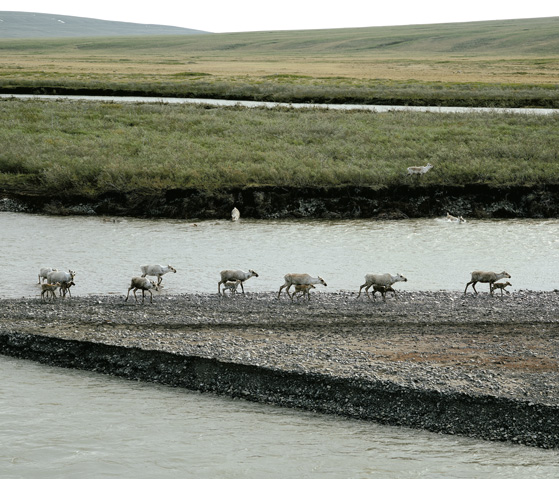
Caribou and Calves Crossing the Kokolik River. Coal and the Caribou.
Photograph by Subhankar Banerjee, 2006.

Known and Unknown Tracks. Oil and the Geese.
Photograph by Subhankar Banerjee, 2006.
I think that this kind of engagement and questioning sets arts practice apart from other types of research in that we are more open, more inclined to accept intuition and chance as valuable and important aspects of the creative process in the way we work. And there is something about the creative process and a visual language that provides a certain kind of freedom or emancipates us from the stricter confines or boundaries of other disciplines. For example, one of my much-exhibited works is the Caribou Migration. This particular photograph grew out of a close working relationship with a biologist who had studied this particular caribou herd for decades, and who told me a number of interesting and relevant facts, and encouraged me to take photographs of the herd. But when it was exhibited in 2014 at the Tufts University Art Gallery, an art critic for the Boston Globe reviewed the show giving a religious interpretation, which was not my intention.
So the visual language opens doors for people to decide, and we have no control of what they might think. We have our own intentions but ultimately we cannot know where it will lead.
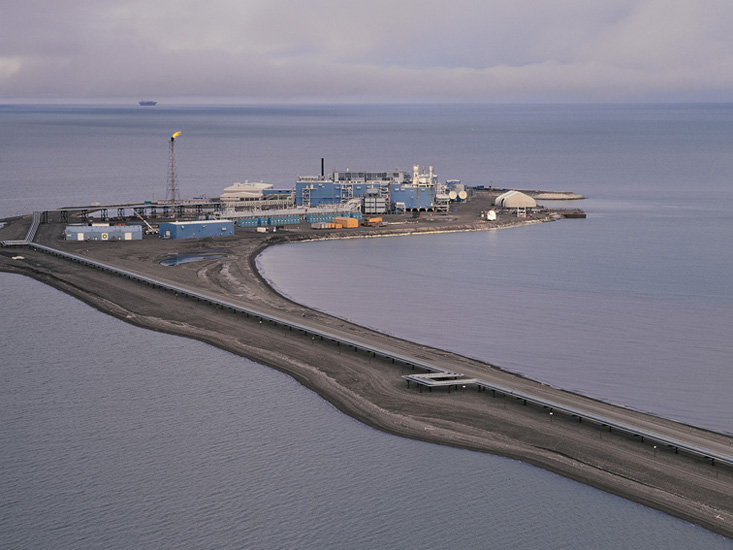
Flaring at Prudhoe Bay.
Photograph by Subhankar Banerjee, 2002.
This, for me, is a really interesting part of the creative process, and one that still remains under the umbrella of research because once you create something it’s not an end but the beginning of something else. As one process finishes the work then has its own journey. As we progress we also reflect and when we reflect we may see things differently to when we first engaged in the research or the making of a particular body of work. And if we speak or write about our work we might connect things that previously we hadn’t seen or realised at the time, and this is a fascinating thing because curiosity is the hallmark of all research.
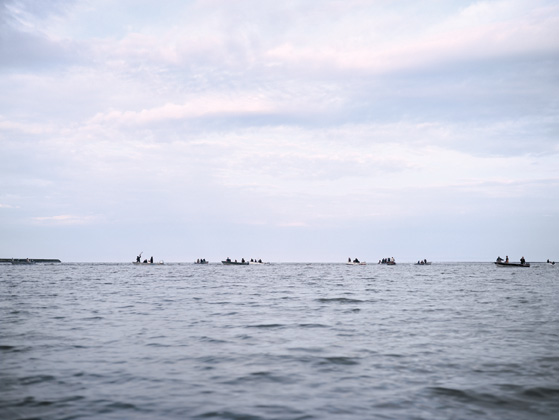
Beluga Whale Hunt. Iñupiat and the Whales.
Photograph by Subhankar Banerjee, 2002.
Interview by Mike Simmons
Notes
1 Subhankar Banerjee (2012). Arctic Voices: Resistance at the Tipping Point. New York: Seven Stories Press.
2 Gwich’in are the indigenous peoples of the Northwest and Yukon Territory of Canada, and also of northern Alaska. See the Gwich’in International Council at www.gwichin.org/gwichin.html for further information.
3 For further information see: The Ecospirituality Foundation at www.eco-spirituality.org/menu-e.htm.
4 The Iñupiaq are Alaskan indigenous peoples. For further information visit the: Alaska Native Knowledge Network at http://ankn.uaf.edu/ANCR/Values/Inupiaq.html.
